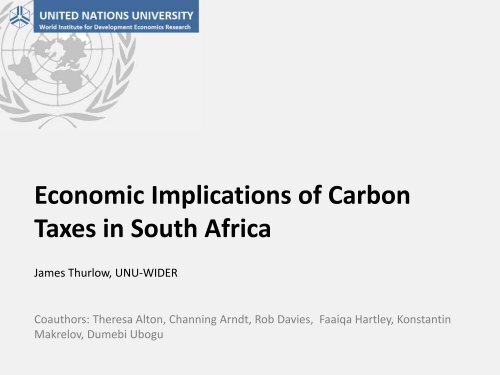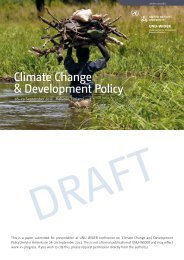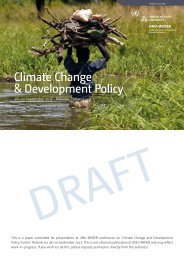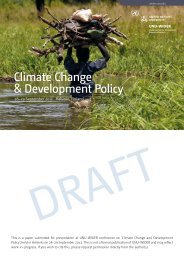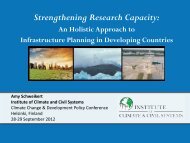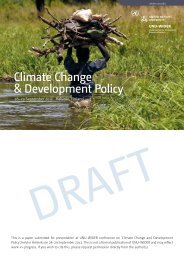Economic Implications of Carbon Taxes in South Africa - UNU-WIDER
Economic Implications of Carbon Taxes in South Africa - UNU-WIDER
Economic Implications of Carbon Taxes in South Africa - UNU-WIDER
- No tags were found...
Create successful ePaper yourself
Turn your PDF publications into a flip-book with our unique Google optimized e-Paper software.
<strong>Economic</strong> <strong>Implications</strong> <strong>of</strong> <strong>Carbon</strong><strong>Taxes</strong> <strong>in</strong> <strong>South</strong> <strong>Africa</strong>James Thurlow, <strong>UNU</strong>-<strong>WIDER</strong>Coauthors: Theresa Alton, Chann<strong>in</strong>g Arndt, Rob Davies, Faaiqa Hartley, Konstant<strong>in</strong>Makrelov, Dumebi Ubogu
<strong>Carbon</strong> Emissions• <strong>South</strong> <strong>Africa</strong> must produce more energy but also reduce emissions– Pledged to lower emissions by 42% by 2025 (relative to bus<strong>in</strong>ess-as-usual)Emissions per unit <strong>of</strong> energy useLow <strong>in</strong>comeUpper middle <strong>in</strong>comeTanzaniaZambiaMozambiqueDR CongoLower middle <strong>in</strong>comeHigh <strong>in</strong>come<strong>South</strong> <strong>Africa</strong>UK DenmarkCh<strong>in</strong>aUSAUAEF<strong>in</strong>landNorwaySwedenLow carbon growth pathCurrent growth pathIcelandEnergy use per personSource: WDINotes: Log scale, Energy use <strong>in</strong> oil equiv.
Energy-Economy Model• <strong>South</strong> <strong>Africa</strong>n General Equilibrium (SAGE) model• 2005 social account<strong>in</strong>g matrix (SAM)– 54 <strong>in</strong>dustries, 7 factors <strong>of</strong> production, 14 household groups• Resource constra<strong>in</strong>ts– Upward slop<strong>in</strong>g labor supply curves for less-educated workers– “Putty clay” capital and endogenous capital accumulation• Macroeconomic closures– Fixed current account with flexible real exchange rate– Sav<strong>in</strong>gs-driven <strong>in</strong>vestment
Energy ProductionCoal-firedNuclearHydropowerGas-firedElectricityPartly exportedCoalNatural gasRenewablesWasteCoal-to-liquidF<strong>in</strong>al usersIndustriesHouseholdsGovernmentInvestmentImportedCrude oilGas-to-liquidOil ref<strong>in</strong><strong>in</strong>gPetroleumFeedstockBi<strong>of</strong>uels
Energy UseEnergy efficiency =Energy <strong>in</strong>putIndustry output• Energy efficiency determ<strong>in</strong>ed by…– Exist<strong>in</strong>g technologies– Energy prices (provided there is new <strong>in</strong>vestment)– New <strong>in</strong>vestment (provided the price rises)
Simulations1. Domestic carbon tax– Applied to all fossil fuels burned <strong>in</strong> <strong>South</strong> <strong>Africa</strong>– Starts at US$3 per ton CO 2 <strong>in</strong> 2012 and rises gradually to US$30 <strong>in</strong> 2022– Uniform reduction <strong>in</strong> <strong>in</strong>direct sales tax rates (distribution neutral)2. Domestic border tax adjustment on embodied carbon– As above, but rebate exporters and tax imports at same carbon tax rate3. Foreign border tax adjustment– <strong>South</strong> <strong>Africa</strong>n exports are taxed at foreign border– Starts at US$1.5 per ton CO 2 <strong>in</strong> 2012 and rises gradually to US$15 <strong>in</strong> 20224. Recycl<strong>in</strong>g revenues– Instead <strong>of</strong> sales taxes, reduce corporate taxes or <strong>in</strong>crease social transfers
Electricity InvestmentsSystem capacity (GW)100908070605040302010Base Case (BAU)Cost: US$108 bil.GasRenewablesHydroNuclearCoal02005 10 15 20 25 30100908070605040302010Policy-AdjustedCost: ???Emissions: -19% <strong>of</strong> BAU by 202502005 10 15 20 25 30100908070605040302010Emissions 3Cost: US$171 bil.Emissions: -42% <strong>of</strong> BAU by 203002005 10 15 20 25 30
Results: Emissions Reductions• A US$30 per ton CO2 carbon tax achieves emissions targets• R<strong>in</strong>g-fenc<strong>in</strong>g <strong>of</strong> electricity means large reduction <strong>in</strong> other sectorsBus<strong>in</strong>essas-usual,2010Changes <strong>in</strong> GHG emissions, 2010-2025Deviation from “bus<strong>in</strong>ess-as-usual” scenario, 2025 (%)Policy-AdjustedProductioncarbon taxConsumptioncarbon taxForeigncarbon taxCO 2 emissions (mil.mt) us<strong>in</strong>gthe reference approach 447.5 -8.6 -36.6 -36.2 -19.6Electricity generation 237.0 -19.0 -19.0 -19.0 -19.0Other sectors/households 210.5 0.0 -51.3 -50.5 -20.1CO 2 emissions (mil.mt) us<strong>in</strong>gthe sectoral approach 397.4 n.a. -40.4 -41.4 -21.0
Results: GDP and Employment LossesEconomywide abatement costsSectoral sources <strong>of</strong> lossesDecl<strong>in</strong>e <strong>in</strong> GDP or employment , 2025 (%)1.41.21.00.80.60.40.2<strong>Carbon</strong> tax (US$/mt)$10$5$2.5GDP$40$35$30$25$20$15EmploymentDecl<strong>in</strong>e <strong>in</strong> GDP, 2025 (%)1.41.21.00.80.60.40.2ServicesConstructionManufactur<strong>in</strong>gM<strong>in</strong><strong>in</strong>gAgriculture0.00 10 20 30 400.00 5 10 15 20 25 30 35 40Decl<strong>in</strong>e <strong>in</strong> GHG emissions, 2025 (%)<strong>Carbon</strong> tax (US$/mt)
Results: Income DistributionConsumption growth <strong>in</strong>cidence curves6543210-1-2-3-41-1011-2021-3031-4041-5051-6061-7071-8081-9091-96979899100Deviation <strong>in</strong> consumption, 2025 (%)Corporate taxSales taxRetaliatory taxSocial transfersRanked population per capita expenditure percentiles
Conclusions• <strong>Carbon</strong> taxes reduce national welfare and employment– Absorption and employment fall by 1.2 and 0.6 percent, respectively, by 2025– These effects are small <strong>in</strong> annual growth rate terms (less than 0.1 %-po<strong>in</strong>ts)• Welfare and employment losses are larger if RSA’s trad<strong>in</strong>g partnersunilaterally impose BTAs on <strong>South</strong> <strong>Africa</strong>n exports• Domestic BTAs reduce welfare and employment losses whilema<strong>in</strong>ta<strong>in</strong><strong>in</strong>g the same emissions reductions• Mode <strong>of</strong> revenue recycl<strong>in</strong>g strongly <strong>in</strong>fluences growth anddistributional outcomes (i.e., trade-<strong>of</strong>fs)


